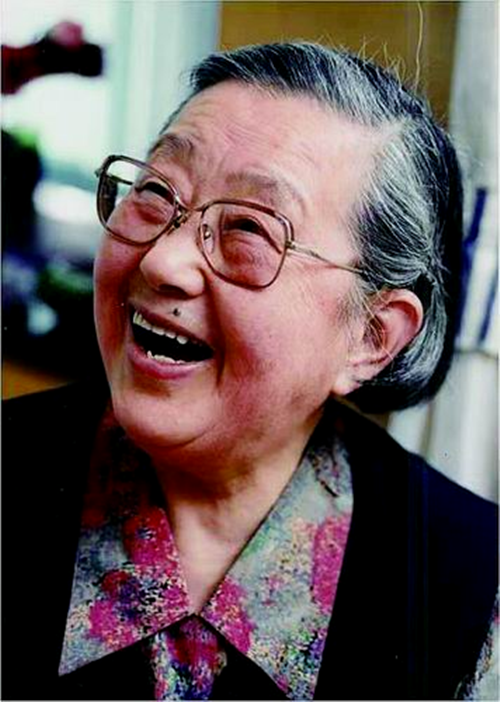Yin Wenying: 'I spend my life studying the tiny'

Yin Wenying[Photo/Academic Divisions of the Chinese Academy of Sciences]
On the Tianmu Mountain in August, Yin Wenying turned over stones, brushed aside fallen leaves, dug up piles of soil, and stumbled upon a tiny off-white "thing" wriggling. Upon the discovery, her heart skipped a beat - could it be a proturan?
Proturans are tiny animals with a body length of only about 1 millimeters and live in soil all their lifespan, which makes them difficult to be found. Yin planned to take it back to the laboratory for further identification. How to get the "tiny" out of the soil? She had an idea —plucking a hair from her head, wetting it in her mouth, then getting the little hexapod onto the hair and into a specimen tube.
This happened in 1963, marking the inception of Yin's proturan research career. Yin was a well-known entomologist in China. Throughout her life, she engaged in three main areas of research: fish disease control, proturans systematic taxonomy, and soil zoology. In her own eyes, it was just "insignificant work", but in the eyes of the famous Italian entomologist Romano Dallai, Yin deserved the honor "an exceptional lady".
To be a learned person
Yin's father, Yin Zanxun, was a famous geologist and paleontologist in China. Whenever he went out to collect specimens on holidays, Yin Zanxun would bring his daughter with him. Although she couldn't yet understand the mysteries beneath the stones, Yin Wenying developed an interest in nature during her childhood. Flowers, grasses, insects and worms were all her favorites.
"My father used to say, 'Mastering a foreign language is equivalent to having another pair of eyes.' In those days, father would invite a few scholars who had returned from Germany to have a weekly salon. My father taught them French, and they taught him German. I would sit by them and listen intently, though I understood nothing. I was fond of such vibes and gatherings."
In Yin Wenying's heart, her father is "a man with great learning". "Father's imperceptible influence produced indelible imprints on my innermost being, nurturing my longing for science, aspiration to explore nature, and ambition to be a learned person!"
Yin Wenying did not become a geologist as she had originally planned. She studied biology. In her research, she continued to explore and advance, staying true to her unyielding will.
'I will gain the inevitable triumph'
In Yin Wenying's career, the most important work was the phylogenetic taxonomic study of proturans. In 1965, she discovered a unique morphological species of Sinentomon erythranum and accordingly established a new family, Sinentomidae, the fourth family of the order Protura.
Although this achievement is widely recognized as a milestone in the academic community, the status of Sinentomidae in phylogenetic taxonomy varied greatly among scholars. Thus began an academic debate!
"Ms. Yin, please take a closer look, and you will agree with me."
"Mr. Turgeson, you must also admit that Sinentomidae is quite special. I have every reason to stand by my opinion."
This conversation took place in 1979 during Yin Wenying's visit to the Zoological Museum of the University of Copenhagen in Denmark. It was between Yin Wenying, an unknown, ordinary scientific researcher, and Turgeson, the honorary life president of the International Congress of Entomology and an authority on the taxonomic study of proturans.
At that time, Turgeson believed that Sinentomidae was not the same as the known proturans and could not be included in the protura taxonomic system he had established in 1964. However, he firmly disagreed with Yin's claim that it should be classified as a suborder of ancient proturans.
After Yin Wenying returned to China, Turgeson sent her a letter with a list of 17 questions.
Yin Wenying was confident that "I will gain the inevitable triumph" because of her prudent and reliable study. But what evidence could she use to convince this stubborn old man?
Yin Wenying thought that the changes in the germ cells of organisms might be the most convincing in terms of phylogenetic taxonomy. So, she overcame various difficulties and began a systematic comparative spermatozoa study on proturans in 1980.
In the following decade, she and her peers observed and compared the sperm ultrastructures of 20 protura species from 16 genera across eight families using electron microscopes.
Their findings strongly supported Yin Wenying's taxonomy. She never forgot Turgeson's 17 questions. "It was his questions that broadened my thinking, deepened my understanding, and drove me to continue to pursue the truth.”
'Anything classic has limitations'
The taxonomic controversy surrounding the Sinentomidae family prompted Yin to take the lead in introducing ultrastructure research into China's taxonomic studies.
"As we know, anything that labels itself as classic has limitations in both time and space. The continuous development of science and the growth of human understanding will inevitably lead to new discoveries and new theories." In breaking through traditional taxonomies, Yin Wenying advocated innovation and the integration of strengths from multiple disciplines.
In traditional taxonomy, proturans are classified as wingless insects. However, as her study deepened, Yin Wenying found that the morphological characteristics of proturans were quite different from those of winged insects and even showed significant differences compared to the other three orders within the wingless subclass. So, she boldly questioned, "Are proturans insects or not?" This immediately drew attention from relevant scholars both domestically and internationally.
Yin Wenying understood that traditional taxonomic methods could no longer adequately address this question. She needed to find an alternative approach.
Yin Wenying turned to molecular genetics and electronic computers, hoping to use molecular biology methods to clarify the molecular characteristics of major arthropod groups and to apply mathematical classification techniques to determine the genetic relationships among major groups. Her goal was to establish an appropriate taxonomic status for proturans. China's first papers on the molecular taxonomy and genome analysis of proturans were authored by Yin Wenying and her students.
In 2002, 80-year-old Yin Wenying personally presided over a key project of the National Natural Science Foundation of China - research on the evolution and taxonomic status of the higher-order system of living hexapods.
'Only science can save China'
Growing up amid turmoil and wars, Yin Wenying witnessed foreign invasions and was deeply influenced by the intellectuals of her father's generation who insisted on "saving the country with science". At the age of 19, Yin Wenying wrote the article "Only science can save China". Since then, the idea of "building the country with science" became the driving force behind her lifelong perseverance and hard work. Throughout her research career, she always prioritized the needs of the country.
Years ago, Yin Wenying, who graduated in biology, engaged in the classification and identification of fish parasites. After the founding of the People's Republic of China, to meet the developmental needs of freshwater fisheries, she devoted herself to experimental research on fish disease prevention and control.
In the mid-1980s, when the country set forth the grand goal of science serving production, Yin Wenying keenly identified soil biological resources as the "fertilizer factories" for arable land and the "cleaners" for environmental pollutants. Consequently, she began contemplating conducting soil zoological research in China.
Yin Wenying, along with experts from home and abroad, pioneered large-scale and systematic soil zoological research in China for the first time. Over the decade following their initial research, they traveled to seven different geographical areas in temperate, subtropical and tropical regions across China to conduct background surveys of soil animals. They compiled and published five monographs, including Atlas of Chinese Soil Fauna, which contains more than 1,400 genera of eight animal phyla. Their work significantly contributed to the establishment and in-depth development of soil zoology in China.
Throughout her life, Yin Wenying demonstrated a brilliant patriotic spirit.








